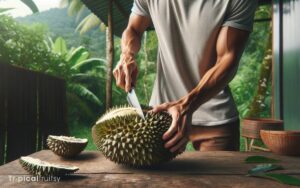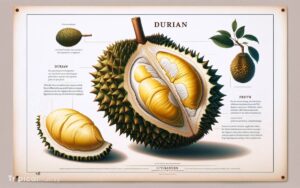How to Know If Durian Is Spoiled? 8 Easy Steps!
To determine if a durian is spoiled, you must assess its aroma, texture, appearance, and the condition of the stem.
A fresh durian will have a strong, distinct smell that is not sour, a creamy texture without sliminess, no discoloration or mold on the outer shell, and a stem that is neither too dry nor moist.
Identifying a spoiled durian involves:
Ensure the king of fruits is fit for royalty by checking for a characteristic aroma and a creamy, mold-free texture.
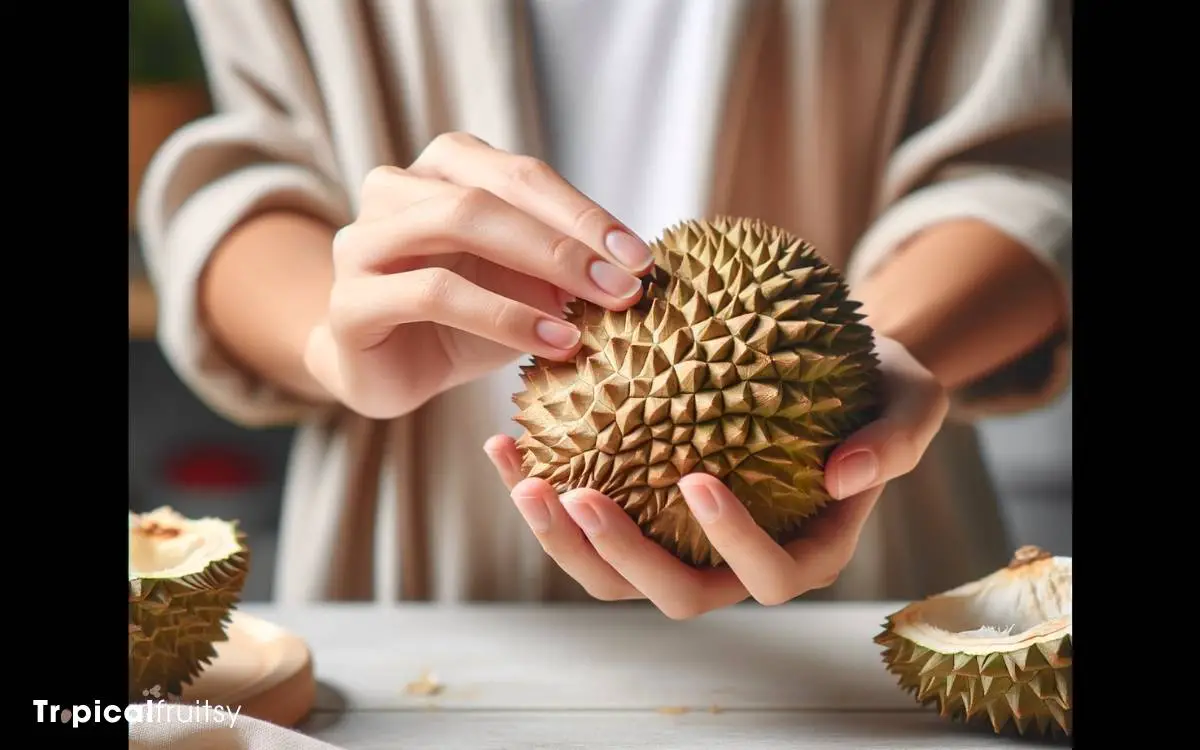
Key Takeaway
Step 1: Assessing the Aroma
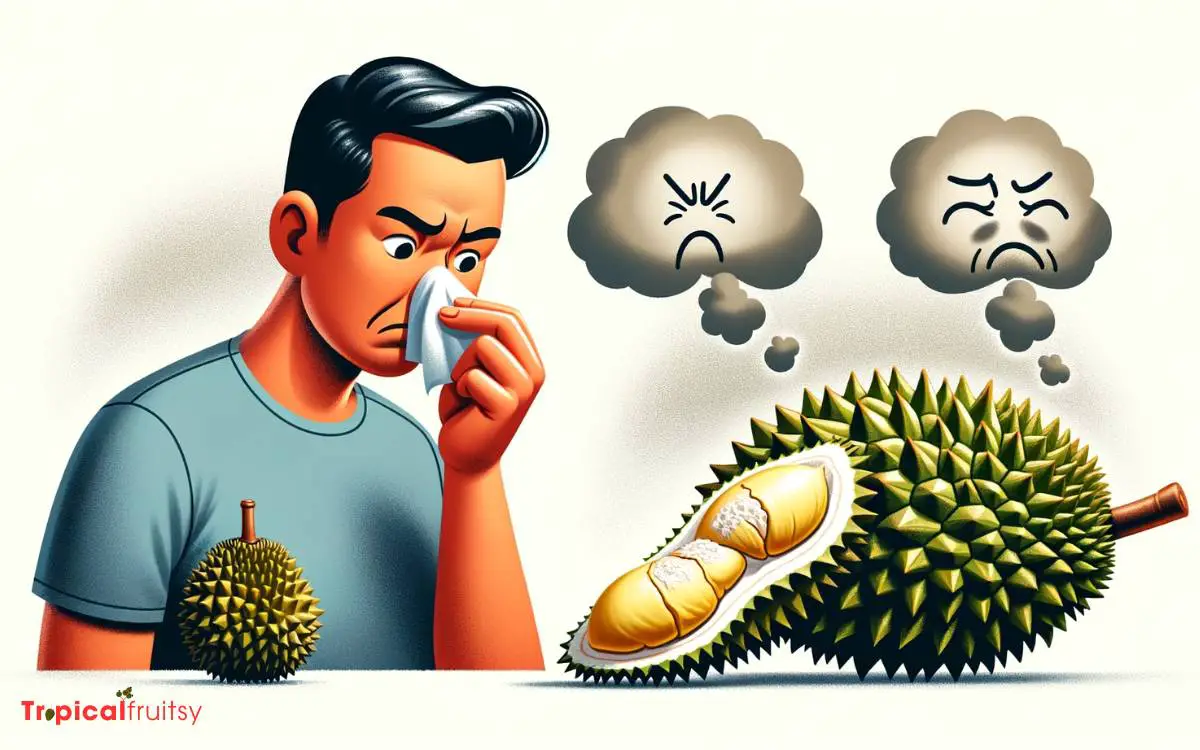
How can one discern the freshness of durian when its naturally pungent aroma is a characteristic of even the unspoiled fruit?
To evaluate its freshness, one must analyze the nuances of the durian’s scent beyond its initial overwhelming pungency.
A fresh durian typically emits a rich, ripe smell that is strong but not unpleasant. In contrast, a spoiled durian will often have a sour or alcoholic odor indicative of fermentation or rotting processes.
This distinction requires an astute olfactory assessment, as the difference can be subtle to the untrained nose.
Consumers should also be aware that external factors, such as storage conditions, can influence the fruit’s aroma. Ensuring precision in this evaluation is crucial before proceeding to examine the texture of the fruit.
Step 2:Examining the Texture
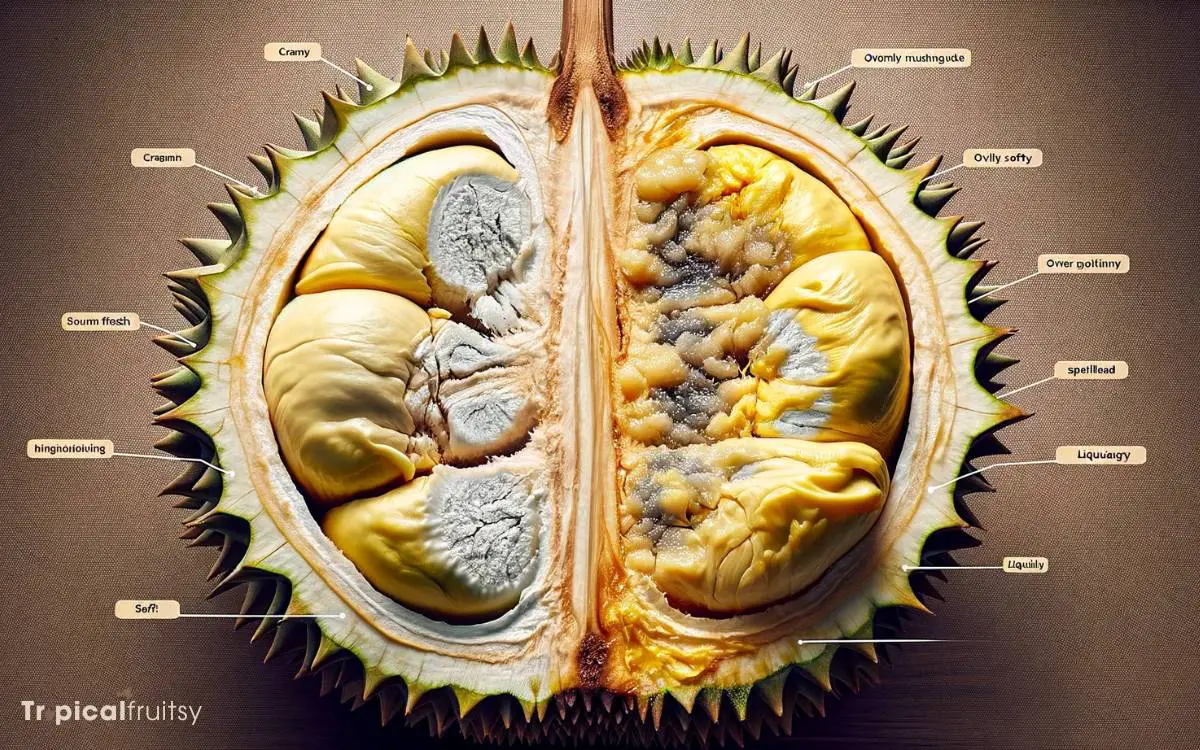
Commonly, after evaluating the aroma, the next step in determining the freshness of a durian is to carefully inspect its texture for signs of spoilage.
When examining the texture, a methodical approach is essential:
- Firmness: A fresh durian should be firm to the touch, but with a slight give. Overly soft or mushy flesh may indicate decay.
- Consistency: The flesh should be creamy; any liquidity or excessive dryness can be a sign of spoilage.
- Intactness: Look for segments that are intact. If the flesh appears disintegrated or overly stringy, it may be past its prime.
- Stem Attachment: The area around the stem should be secure; if the stem is detached or the surrounding area is overly soft, the fruit may be too ripe.
- Surface anomalies: Check for unusual spots or mold, which are clear indicators of spoilage.
Recognizing these textural deviations will guide consumers in avoiding spoiled durian.
Step 3:Recognizing Color Changes
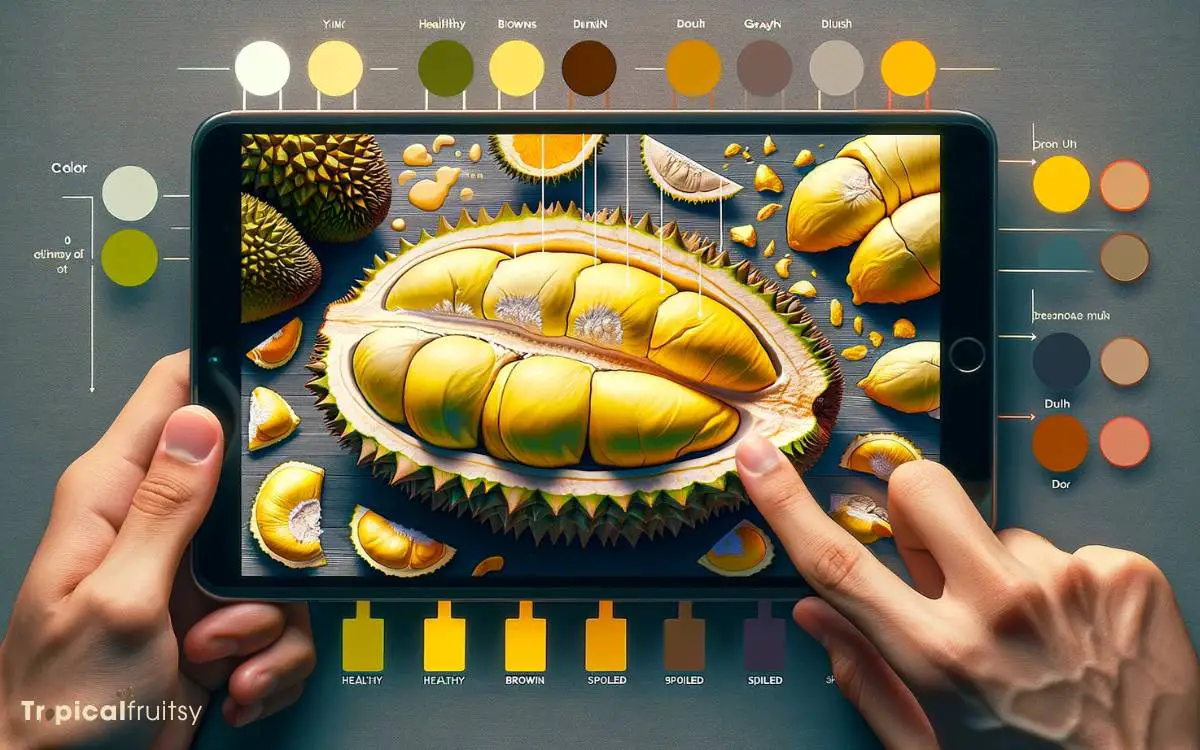
When assessing the freshness of durian, one must carefully consider any variation in color, which can be an indicator of spoilage.
Normal hues of durian flesh range from pale yellow to deep amber, and any significant departure from this spectrum may point to decomposition.
Specifically, the presence of unusual dark spots or a general dullness in the rind color could signify that the fruit has surpassed its optimal consumption period.
Normal Vs. Abnormal Hues
Within the context of assessing durian fruit quality, distinguishing between its normal creamy yellow hue and any abnormal color variations is crucial for identifying spoilage. As the fruit’s appearance is a key indicator of its freshness, careful observation is required.
Note the following characteristics:
- Consistent Creamy Yellow: The flesh should be uniformly colored without dark spots.
- Bright and Vibrant: A fresh durian’s flesh should appear lively and not dull or grayish.
- Absence of Brown or Black Areas: These colors often indicate overripeness or fermentation.
- No Greenish Tinge: Such a hue could suggest the fruit is underripe or has been exposed to unfavorable conditions.
- Uniformity in Color: Patches of discoloration may signal internal rotting or bruising.
A methodical examination of these aspects will yield a precise assessment of the durian’s condition.
Discoloration Signs
Moving on to the signs of discoloration, it’s important to recognize that any deviation from the durian’s natural creamy yellow hue may be indicative of spoilage.
A durian’s flesh should exhibit a uniform color. Noticeable brown or grayish tones, particularly around the seams or beneath the surface, typically suggest an overripe or compromised state.
When examining the fruit, it is critical to scrutinize the color consistency. Patches of discoloration can often signal localized spoilage, which may not affect the entire fruit but does warrant caution.
A thorough inspection should be conducted to ensure that the flesh has not transitioned beyond its peak edibility. Thus, color change in a durian is a reliable metric for identifying potential spoilage.
Rind Color Shifts
Beyond the flesh, the durian’s rind offers additional clues to spoilage, with color shifts from its typical greenish-brown hue to darker tones often indicating decomposition.
When assessing the rind, it is critical to observe the following:
- A transition to a uniformly dark brown or black color suggests advanced spoilage.
- Dullness in color, rather than a slight sheen, can signal the onset of decay.
- Uneven color patches may denote localized spoilage or bruising.
- A rind that appears mottled with spots of discoloration may indicate fungal growth.
- Any color deviations from the durian’s natural mature color warrant a closer examination for other spoilage signs.
With the rind inspected, one should next scrutinize the stem area for additional indicators of the fruit’s condition.
Step 4: Checking the Stem Area
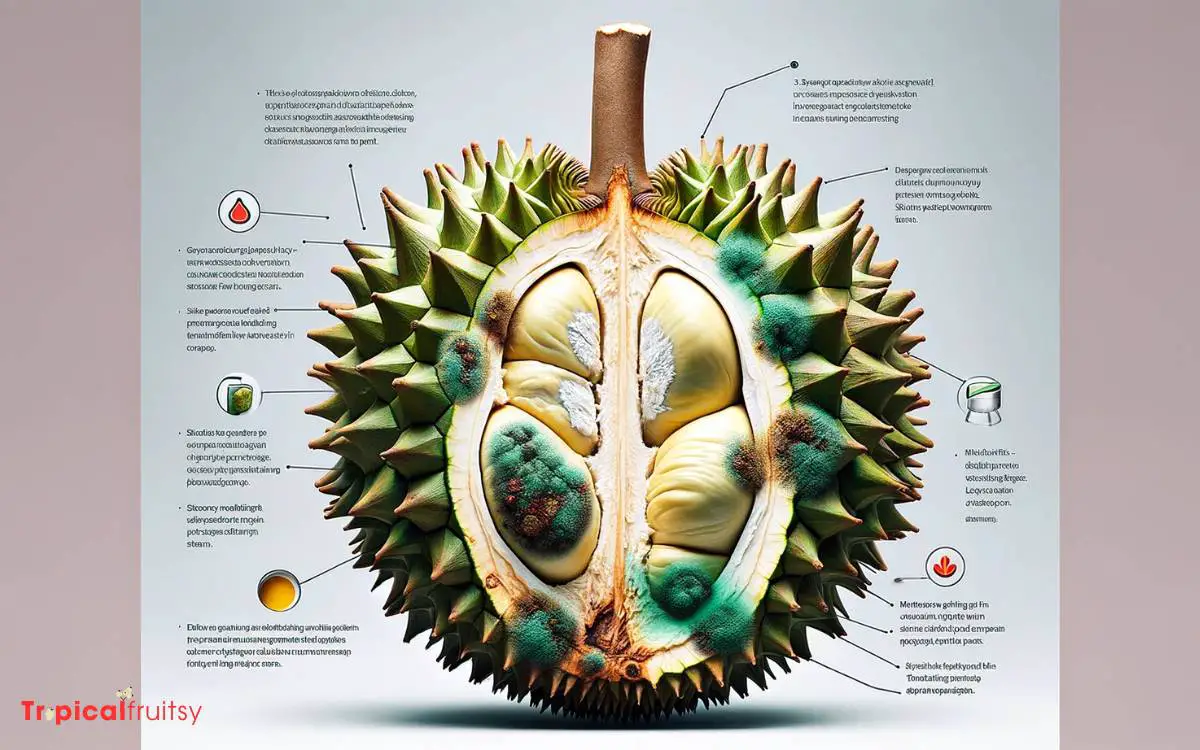
Upon inspecting the stem area of a durian, signs of spoilage may include a dry, shriveled appearance or the presence of mold.
This specific region is indicative of the fruit’s freshness and overall health; a robust, green stem suggests vitality, whereas a withered stem signals degradation.
An analytical approach would entail a close examination for any discoloration or fungal growth, both of which are red flags.
It is crucial to scrutinize this area methodically, as the stem is a conduit for nutrients when the fruit is unripe, and its condition post-harvest can influence the flesh quality.
An intact, moist stem could imply that the fruit has been recently harvested, thus less likely to have spoiled. Conversely, a compromised stem area is a precise indicator that the fruit may be past its prime.
Step 5: Feeling for Firmness
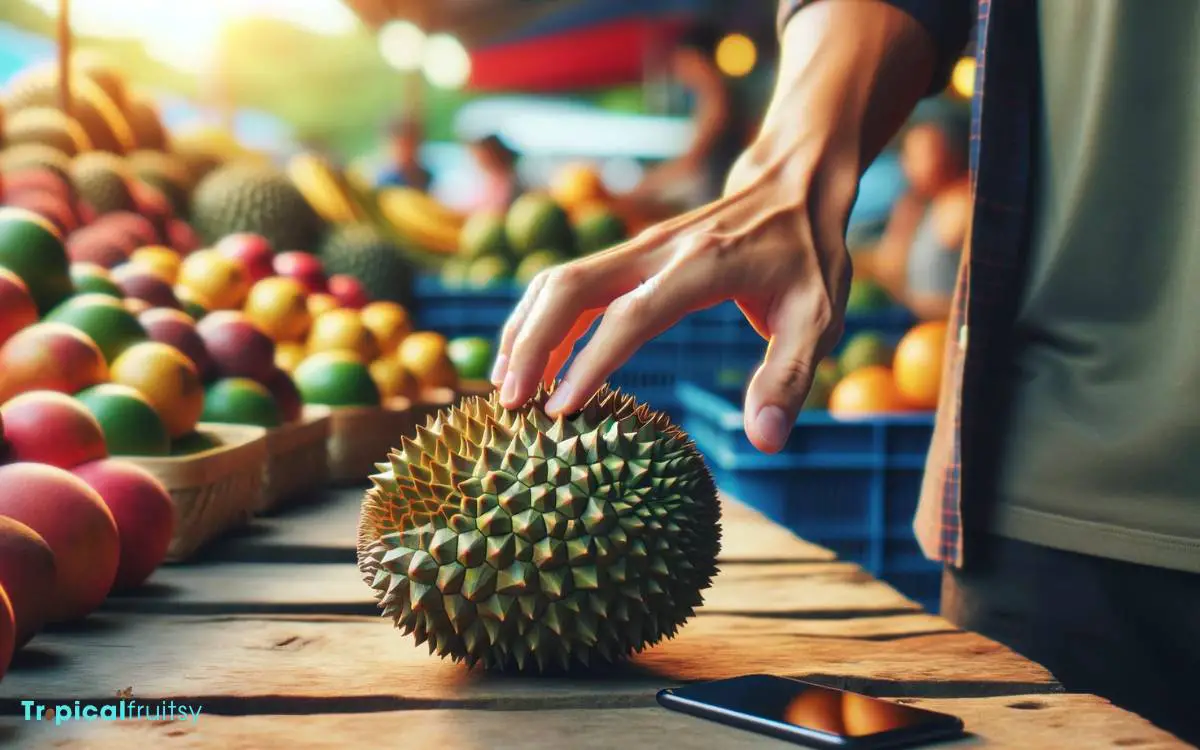
Assessing the firmness of a durian provides tangible cues regarding its freshness. An over-soft texture often signifies spoilage, whereas a durian with a hard exterior may indicate proper preservation.
It is crucial to apply a consistent pressure when evaluating firmness to ensure an accurate assessment of the fruit’s condition.
Softness Indicates Spoilage
Consistency of the durian flesh can be a critical indicator of spoilage; overly soft or mushy texture often signifies that the fruit is no longer fresh.
When assessing the firmness of a durian, consider the following points:
- Uniform Pressure: Apply gentle, even pressure to the durian’s exterior.
- Resilience: Fresh durian flesh should yield slightly but bounce back.
- Surface Tension: Spoiled durian may exhibit a lack of surface tension, feeling limp.
- Comparative Firmness: Compare with a known fresh durian if possible.
- Hand Feel: Trust the tactile feedback; experienced handlers discern freshness by how the fruit feels in the hand.
An analytical approach to feeling for firmness will yield more accurate assessments, reducing the risk of consuming spoiled durian.
Hard Exterior Preservation
In addition to assessing the softness of the flesh, determining the integrity of a durian’s hard exterior is essential for evaluating its freshness. A meticulous examination of the durian shell can provide vital clues.
The shell should feel firm to the touch and not exhibit any signs of excessive give upon gentle pressure, indicating the fruit is likely still fresh. Conversely, a compromised exterior might suggest interior spoilage.
The table below illustrates key aspects to consider when examining the durian’s exterior:
| Aspect | Fresh Durian | Spoiled Durian |
|---|---|---|
| Firmness | Resistant to pressure | Yields easily to pressure |
| Texture | Uniformly rugged | Soft spots or sunken areas |
| Color | Consistent, natural hue | Discoloration or dark spots |
This systematic approach ensures an accurate assessment of durian quality.
Step 6: Spotting Surface Mold
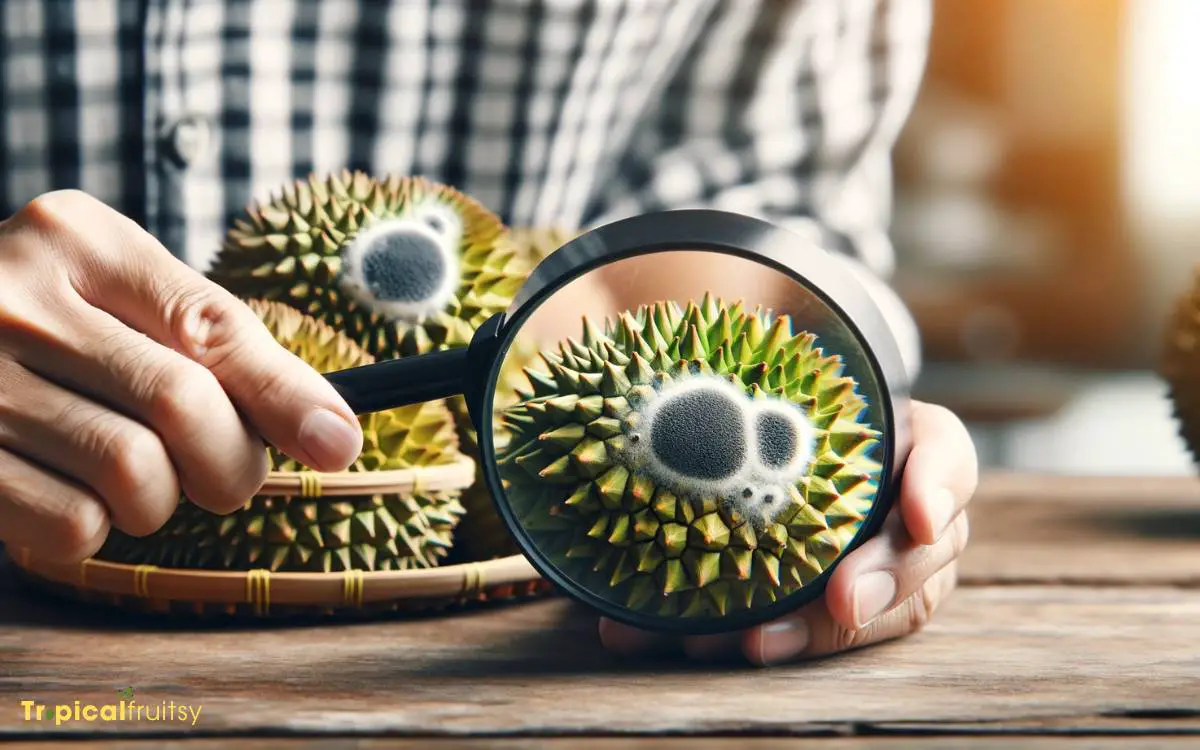
Spotting surface mold on a durian is a clear indication that the fruit may have spoiled and should be inspected further before consumption.
When examining a durian for freshness, a methodical approach should be employed to identify mold growth. This fungal presence is not only undesirable but could also pose health risks if ingested.
Look for the following signs:
- Discoloration: Unusual spots or areas with a distinctly different color from the rest of the durian surface.
- Fuzzy Growth: The appearance of cotton-like structures, which is characteristic of mold colonies.
- Odor Change: A musty or sour smell that deviates from the durian’s natural pungent aroma.
- Texture Alteration: Softness or breakdown of the outer skin where mold is present.
- Pattern Formation: Mold often grows in a circular pattern or in clusters.
Analyzing these characteristics requires a precise and cautious approach to ensure food safety.
Step 7:Observing the Shape
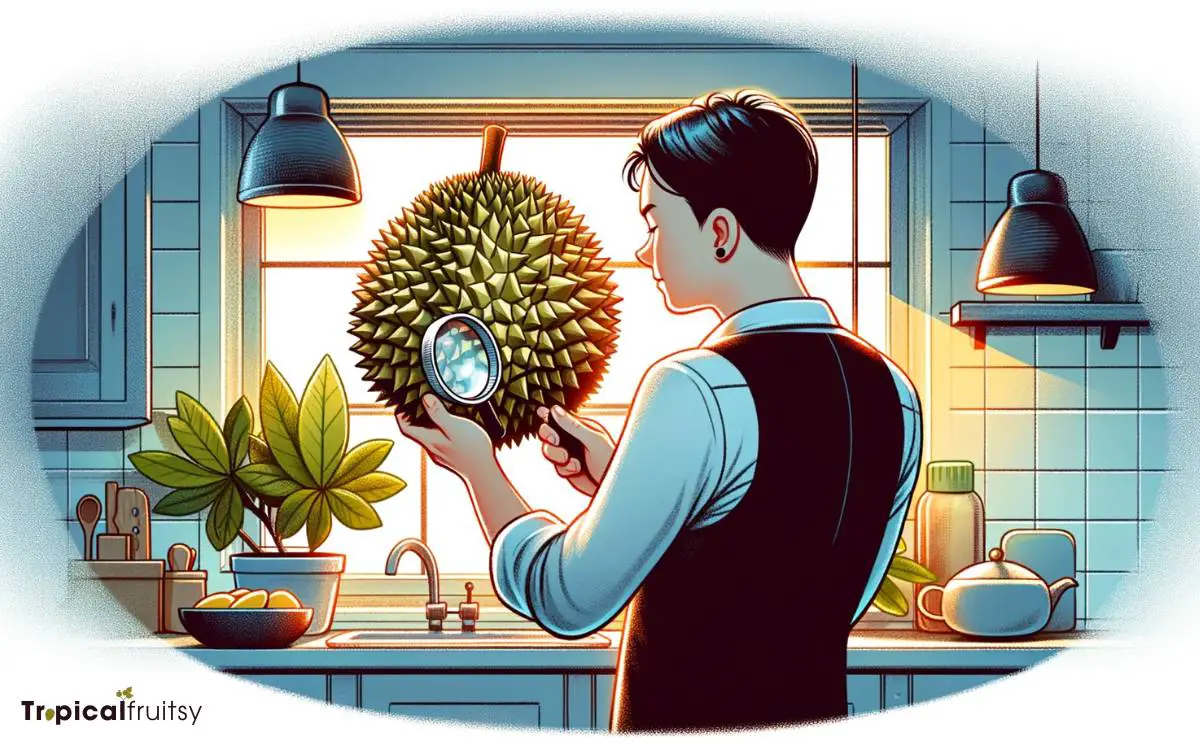
Beyond surface mold analysis, examining the durian’s shape can provide further insight into its freshness, as deviations from the fruit’s typical round or oblong form may signal spoilage.
A durian that displays an irregular shape, such as dents or flattened areas, may have experienced mishandling or internal decay.
One should perform a systematic evaluation of the durian’s exterior for asymmetry, as a uniform shape typically denotes a healthier fruit.
Additionally, an intact, sturdy stem and the absence of cracks or unusual bulges contribute to the assessment of the durian’s structural integrity. Durians that pass this visual examination are more likely to be fresh.
After the visual and tactile assessments are complete, the next logical step in the evaluation process involves trusting your taste buds.
Step 8:Trusting Your Taste Buds
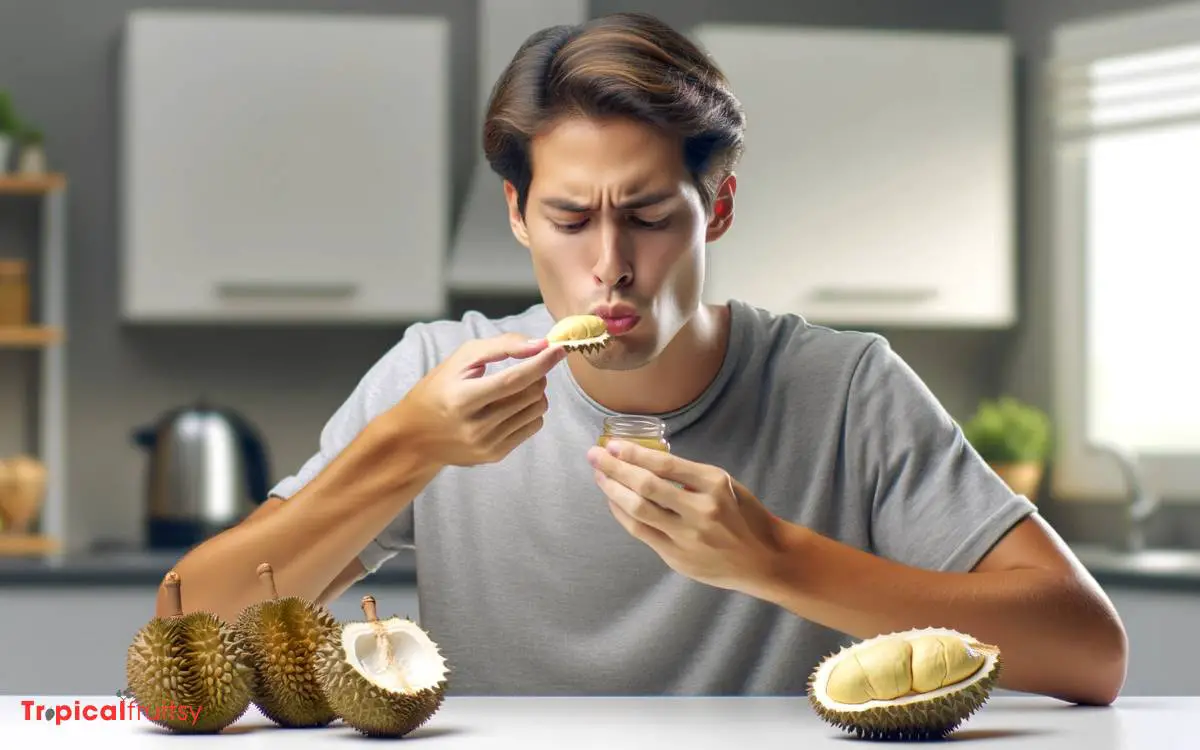
Taste testing remains a decisive method in determining a durian’s edibility once visual and tactile examinations are inconclusive.
When evaluating the fruit’s freshness, it is essential to approach the process with an analytical mindset, focusing on the following sensory cues:
- Sweetness: A fresh durian should possess a natural, subtle sweetness.
- Bitterness: While some bitterness is characteristic, excessive bitterness can indicate spoilage.
- Alcohol Flavor: A fermented or alcoholic taste often signifies over-ripeness or decay.
- Sourness: Any pronounced sourness can be a clear sign of spoilage.
- Consistency: Pay attention to the texture; a spoiled durian may have an unexpectedly watery or overly mushy consistency.
These markers should guide consumers in accurately assessing the condition of the durian, ensuring a safe and enjoyable consumption experience.
Conclusion
Discerning the freshness of a durian requires meticulous scrutiny. Evaluating its aroma, texture, color, stem condition, firmness, surface integrity, and overall shape provides a comprehensive analysis.
Additionally, a cautious taste test can offer definitive evidence of spoilage.
By employing these methods with precision, consumers can adeptly navigate the sensory complexities of this fruit, ensuring that the durian’s unique culinary experience remains uncompromised and enjoyable.

